Dieffenbachia Varieties offer a diverse array of options for indoor plant enthusiasts, each with its own unique charm and characteristics.
From the towering presence of Dieffenbachia Amoena to the compact elegance of Dieffenbachia Compacta, these plants come in various sizes, colors, and patterns, catering to different preferences and spaces.
Whether you’re drawn to the bold variegations of Dieffenbachia Camouflage or the striking foliage of Dieffenbachia White Etna, there’s a Dieffenbachia variety to suit every taste and interior design scheme.
Different Dieffenbachia Varieties for Indoor Spaces
Dieffenbachia Carina
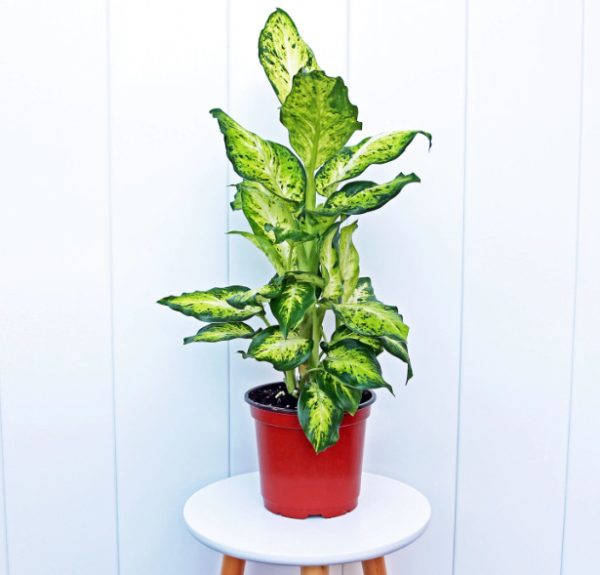
The broad leaves of Dieffenbachia Carina are speckled with green and ivory dots. This type can withstand brief drought spells and is not picky about growing conditions.
Maintain temperatures between 70 and 80 degrees Fahrenheit and water your Dieffenbachia Carina when the top 2–3 inches of soil dry out for optimal results. This maintenance will guarantee healthy growth and colorful foliage.
Dieffenbachia Tropic Snow
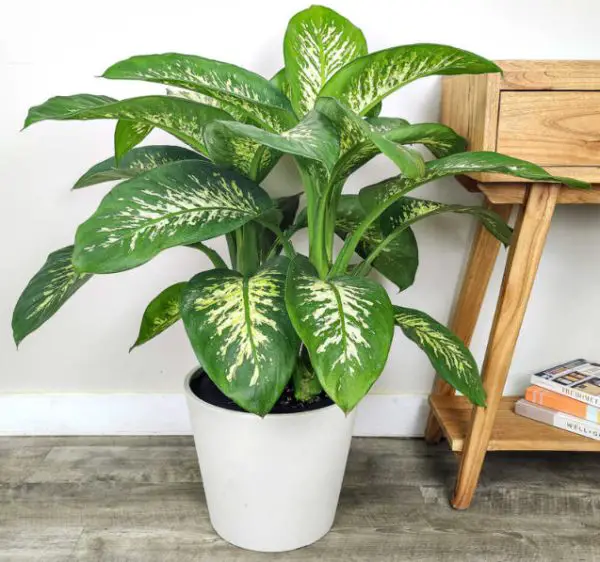
Despite their seeming contradiction, the terms “tropic” and “snow” accurately characterize Dieffenbachia Tropic Snow. Tropic Snow is sometimes confused with Tropical Tiki by growers; however, Tropic Snow has enormous, rectangular leaves with eye-catching gold variegations.
Tropic Snow is one of the largest Dieffenbachia kinds, reaching heights of over 6 feet when conditions are right. With its distinctive leaf and enormous stature, this magnificent plant really pops.
Dieffenbachia Honeydew
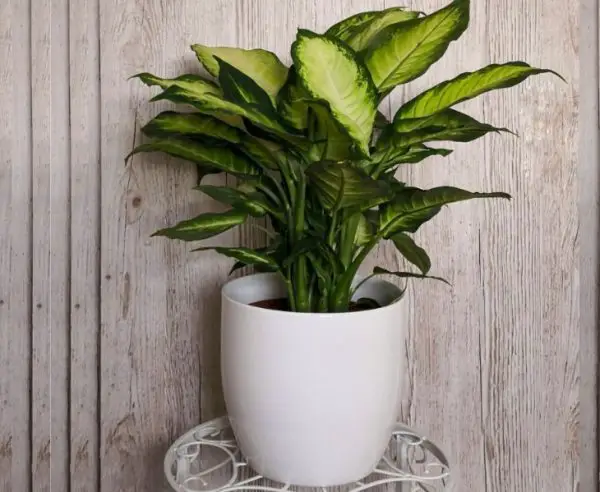
Dieffenbachia Honeydew is prized for its eye-catching look by plant collectors. Its large leaves have vivid yellow centers and rich green borders. High humidity conditions are ideal for this cultivar, ideally above 50%.
If you want to keep the humidity at its ideal level, you can move the plant to a naturally humid environment, such as a kitchen or bathroom, use a humidifier, or put a pebble tray underneath the plant’s pot and spritz the leaves frequently. Your Honeydew Dieffenbachia will remain healthy and vibrant thanks to these precautions.
Dieffenbachia Camille
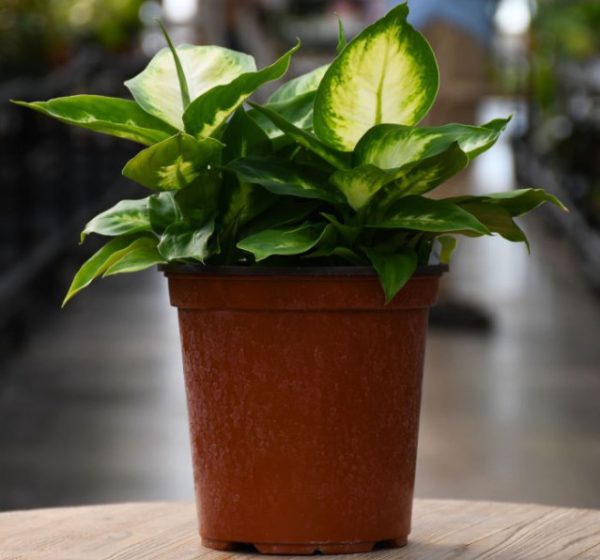
In ideal circumstances, the young, low-maintenance Dieffenbachia Camille dumb cane type can grow up to three feet tall. Its enormous leaves have bright green borders and creamy interiors.
Throughout the growing season, consistent feeding is crucial to guaranteeing optimal growth. With this type, I’ve found that using a balanced triple 20 fertilizer diluted to half strength works well. Dieffenbachia Camille will flourish and bring a splash of rich foliage into your environment with the right upkeep and nutrition.
Dieffenbachia Panther
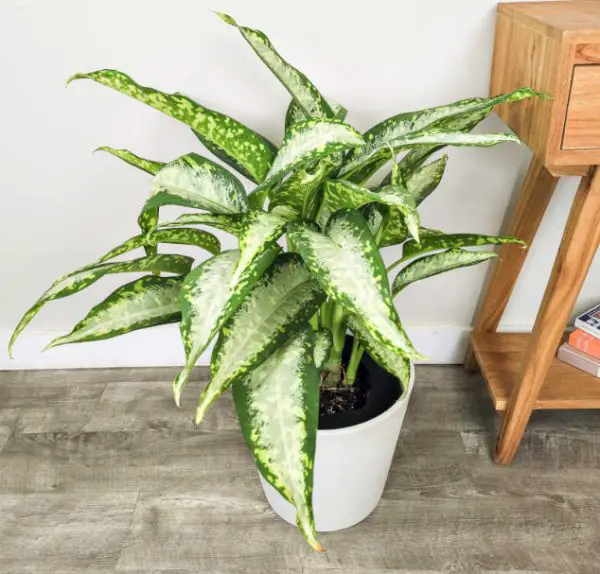
The stunning contrast is achieved by the Dieffenbachia Panther’s rich green foliage speckled with white and various hues of green. It’s a great option for limited areas, such as offices or flats without windows, as its maximum height is three feet.
This type is ideal for interior spaces with little natural light because it flourishes in low light. Use a free-draining, slightly acidic growing medium to maintain its health and provide Dieffenbachia Panther the ideal conditions for growth.
Dieffenbachia Amoena
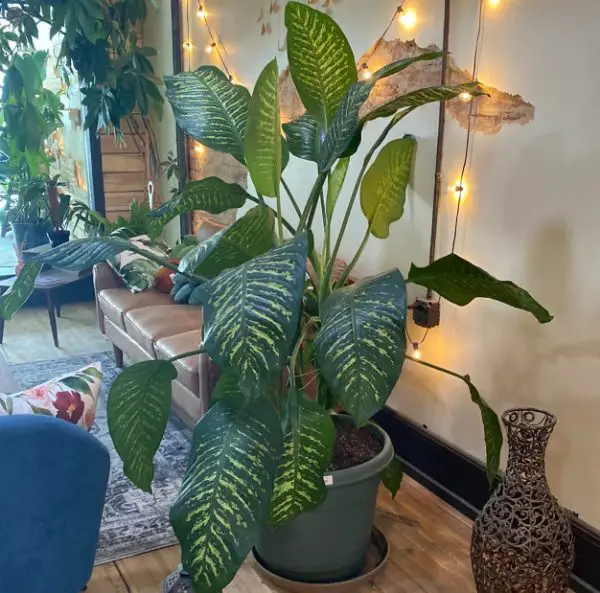
The parent plant of the Tropic Snow cultivar, Dieffenbachia Amoena, grows well indoors. It can grow to a minimum height of six feet and, in ideal circumstances, can have leaves as long as twenty inches. Its oval-shaped leaves have streaks close to the veins and edges and creamy to yellow variegations with dark green dots.
Prior to irrigating, make sure the top two inches of soil are dry. You can use a moisture meter, a bamboo stake, or your fingertips to determine the ideal moisture content for your Dieffenbachia amoena to develop healthily.
Dieffenbachia Mary

Another amazing species is Dieffenbachia Mary, which has vivid green foliage with patches of creamy or deep green color. Mary usually reaches a height of 4 feet; however, she doesn’t bloom indoors. You can grow Mary outside if you live in one of the USDA hardiness zones, which are 10 through 12. Mary should not be exposed to direct sunlight anywhere.
If you are cultivating outside, choose some shade. By taking this precaution, you can keep your Dieffenbachia Mary looking gorgeous, whether it’s in your indoor or outdoor location, by preserving the plant’s health and colorful foliage.
Dieffenbachia Sarah
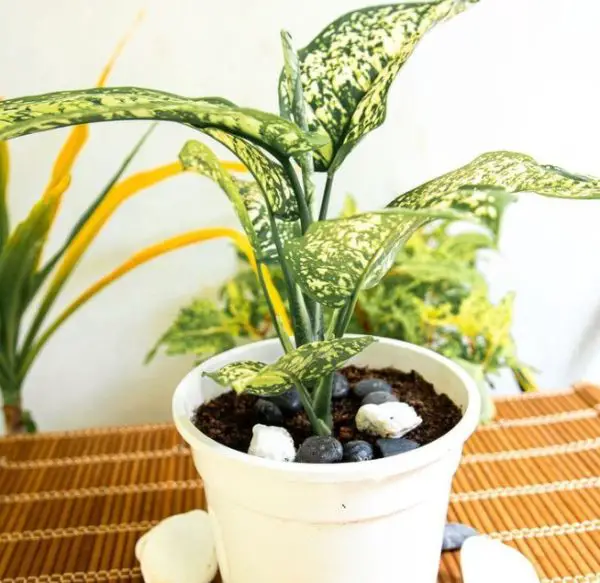
Gorgeous variegated foliage with creamy white spots in the middle and deep green margins characterizes Dieffenbachia Sarah. Sarah grows best in temperatures between 65 and 75 degrees Fahrenheit, so she doesn’t need much watering, especially in the winter.
Sarah is toxic to pets, just like all dumb cane plants, so make sure to put it somewhere out of reach of your furry pals to avoid any unintentional intake.
Dieffenbachia Sarah adds style and greenery to any interior space with its eye-catching look and low maintenance requirements.
Dieffenbachia Snow
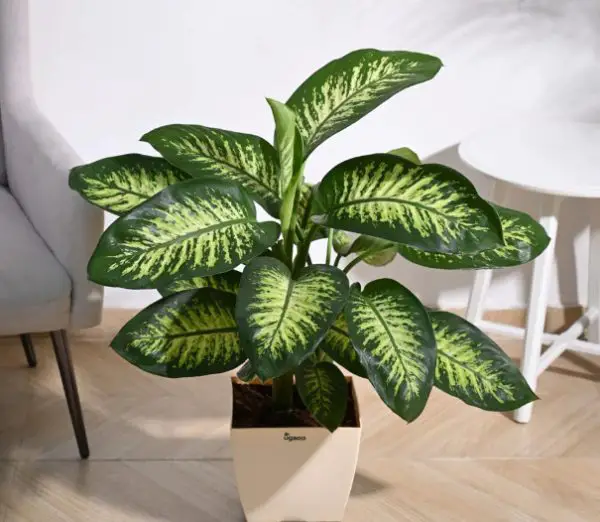
One of the tallest types is Dieffenbachia snow, which may grow to 6 feet quite quickly. Its leaves are a rich green color with patches of creamy white or silvery color. Though it won’t develop to its full size, Snow Dieffenbachia can be grown in water, which is remarkable.
It grows happily and healthily when given regular nourishment and lots of bright, indirect sunlight. Because of its adaptability, Snow is a great option for anyone looking for a visually appealing and low-maintenance indoor green friend.
Dieffenbachia Green Magic
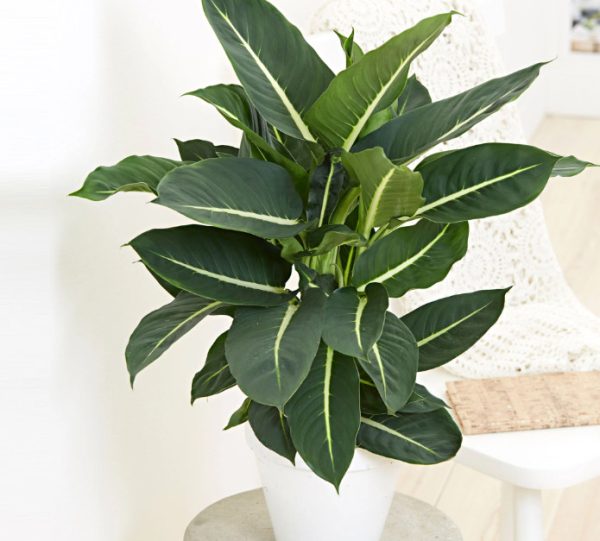
Dieffenbachia Green Magic, which has creamy white main veins and deep green leaves, rounds off our selection. Matured to about three feet, it’s perfect for office desks or bookcases. Green Magic can withstand brief droughts; if you notice it starting to wilt, a good soak will soon bring it back to life.
Green Magic is an excellent option for indoor areas due to its durability and small size, which adds rich greenery and energy to any home or office setting.
Dieffenbachia Imperialis
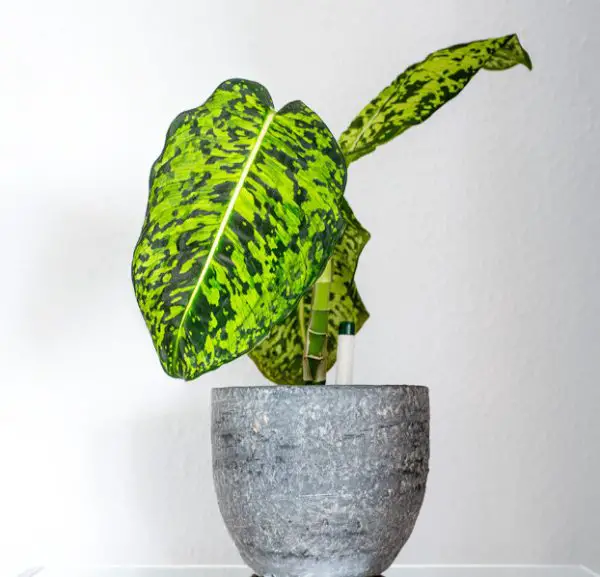
The intriguing oblong leaves of Dieffenbachia Imperialis, a native of Peru, have green and white variegations that get stronger in direct sunlight. It can reach a height of six feet in ideal circumstances.
Since Imperialis is a tropical plant, it needs humidity levels above 60% to stay vibrant and colorful. It grows best in humid settings. Imperialis Dieffenbachia can be multiplied and used to accentuate the greens in your indoor environment by propagating it from stem cuttings.
Dieffenbachia Puerto Rico Variegated
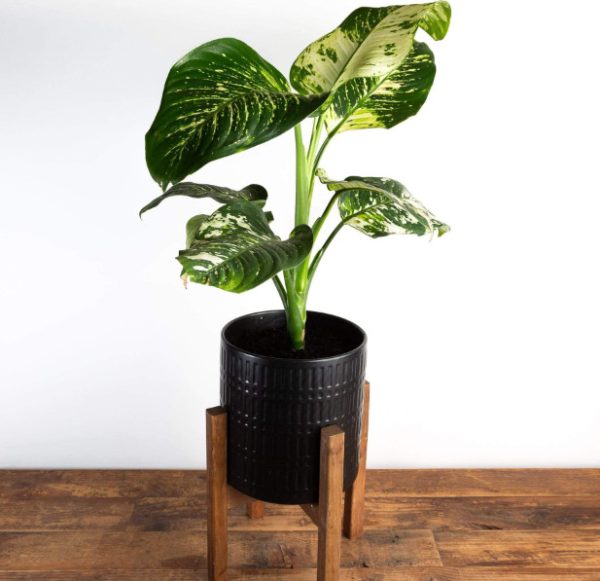
The exotic Dieffenbachia Puerto Rico Variegated plant has lanceolate leaves with white splotches all over the surface; the margins are green with sporadic yellowish undertones. It can withstand lower light levels; however, in reaction to less light, you’ll notice more green on the leaves.
With its distinctive foliage, this cultivar offers a touch of tropical beauty to any indoor room, especially in places with little natural light.
Dieffenbachia White Flame
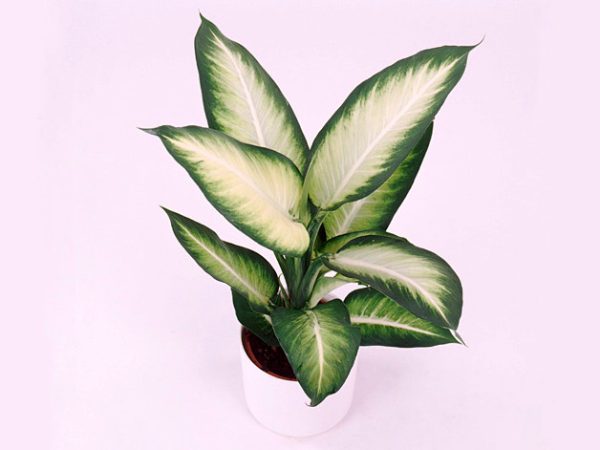
Dieffenbachia White Flame features stunning ovate leaves with deep green edges, a light green middle, and a striking white midrib. With a typical height of under 2 feet, it’s ideal for compact spaces. Planting in compost based on loam ensures a happy and healthy White Flame.
Additionally, regular feeding with a balanced liquid fertilizer will promote optimal growth and vibrant foliage. With its exquisite appearance and easy-care nature, Dieffenbachia White Flame is sure to brighten up any indoor setting.
Dieffenbachia White Etna
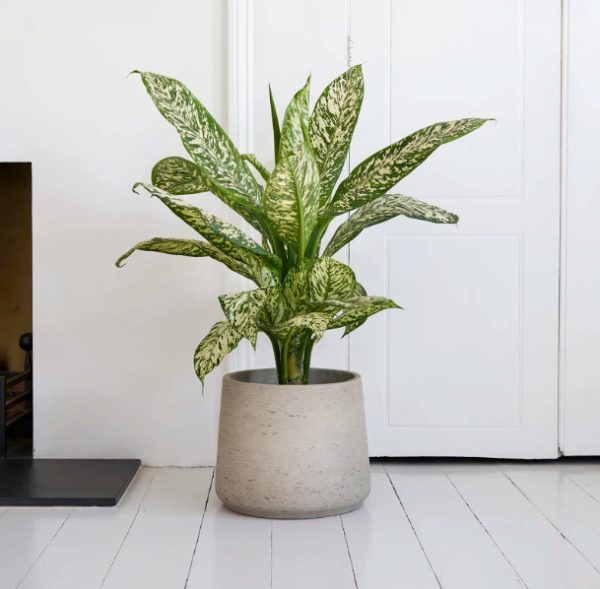
Dieffenbachia White Etna stands out as one of the rarest varieties, featuring oval-shaped, deep green leaves with mottled variegations. Make sure it gets enough light exposure so that its beautiful white variegations remain intact. You may get the ideal amount of light balance by positioning it next to a south-facing window and covering it with sheer curtains.
To keep White Etna Dieffenbachia healthy and vibrant, it is also necessary to keep humidity levels within the prescribed range. This unusual plant will flourish and turn into a gorgeous center piece in any indoor area with the right maintenance.
Dieffenbachia Memoria Corsii
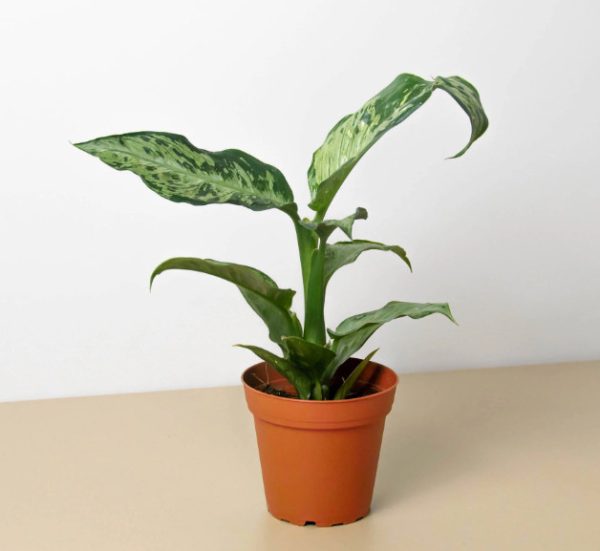
Renowned for its silver and green foliage, Dieffenbachia Memoria Corsii is a popular houseplant. Growing to a height of 4 feet and a width of up to 3 feet, it gives a dramatic presence to any area. Although it is poisonous to pets, this air-purifying plant has health advantages; therefore, keep it out of their reach.
Make sure the ground is continuously wet, giving it a sprinkle when the topsoil appears parched. A substrate that is equal parts perlite, gardening sand, and peat moss will yield the best results.
Dieffenbachia Sterling
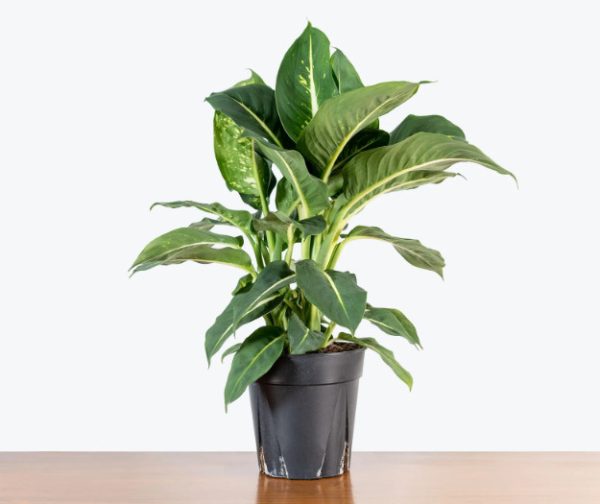
Dieffenbachia Sterling is a fascinating cultivar that stands out for having noticeable creamy or yellowish main veins on its green leaves. Although it can withstand a range of light conditions, direct sunlight needs to be avoided.
Growers can increase the number of beautiful plants in their collection by using stem cuttings, which are an easy and efficient method of propagating the Sterling variety.
Dieffenbachia Sterling is a great option for introducing greenery to indoor spaces because of its distinctive leaves and low maintenance requirements.
Dieffenbachia Sublime
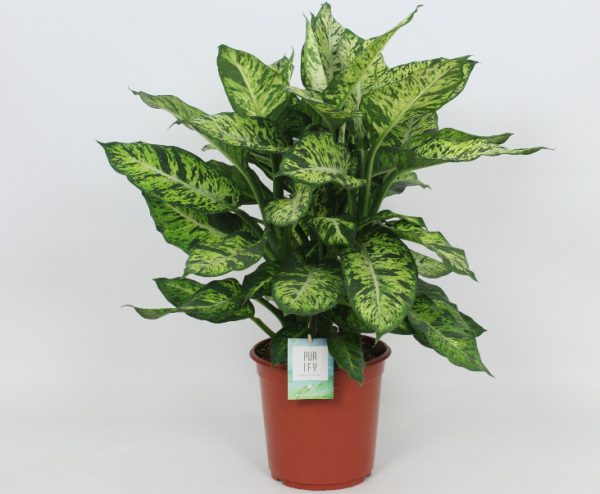
Dieffenbachia Sublime is a great addition to homes and outdoor gardens because of its ovate leaves, which have remarkable variegations of light and deep green. It grows well in USDA zones 10 through 12, yet in colder regions it can be brought indoors when the weather becomes chilly.
While Dieffenbachias sublime don’t usually need a lot of trimming, it’s still important to sometimes remove any broken or discolored leaves to keep the plant looking good. Sublime enriches any indoor or outdoor environment with beauty and brightness, thanks to its adaptable nature and striking foliage.
Dieffenbachia x bausei
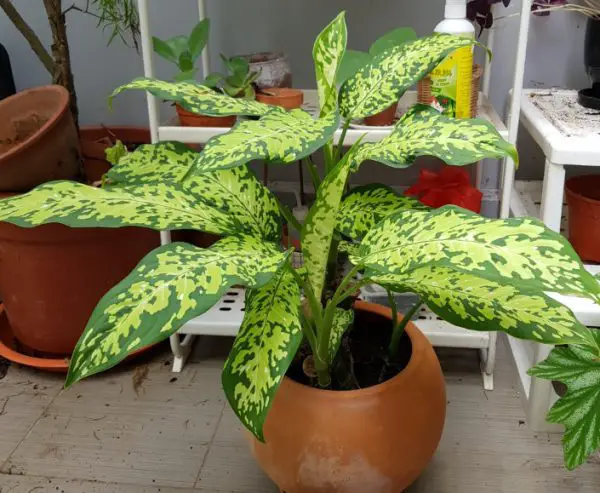
Dieffenbachia x bausei, dating back to 1873, remains a sought-after gem among plant collectors. Its velvety leaves feature yellowish-green hues with deep green margins and speckles, adding to its allure.
This variety thrives in constantly moist soil, but its roots are susceptible to pathogens in stagnant water. To address this, amend the soil with well-draining materials like perlite or pumice.
Dieffenbachia x bausei offers easy propagation through stem cuttings or air-layering, providing enthusiasts with straightforward methods to expand their collection.
Dieffenbachia maculata Tropical Tiki
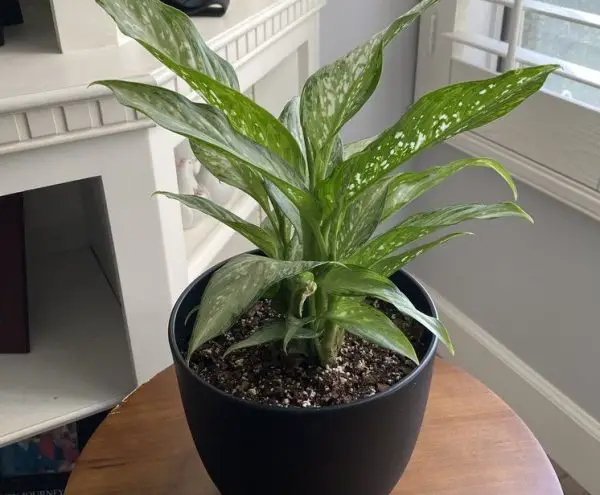
The big, multicolored leaves of Dieffenbachia maculata Tropical Tiki are speckled with a creamy color around the midrib. This plant can grow up to 30 feet tall in its natural habitat, but when grown inside, it usually reaches 3–4 feet.
Since this maculata is quite sensitive to direct sunlight, be mindful of the light levels. Make sure it’s in a good location to protect it from harsh sunshine, which might wither the plant.
Dieffenbachia Rebecca
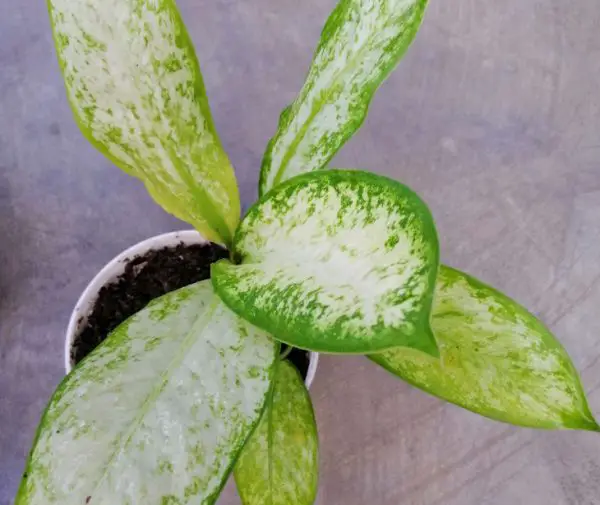
The small Dieffenbachia Rebecca type of dumb cane is distinguished by its vivid color combination and dramatic variegation. This plant needs more intense light to preserve its vivid variegations.
But it’s important to keep it out of direct sunlight because the leaves might burn badly and turn yellow. Maintaining the proper balance of light will help keep the plant healthy and beautiful.
Dieffenbachia daguensis
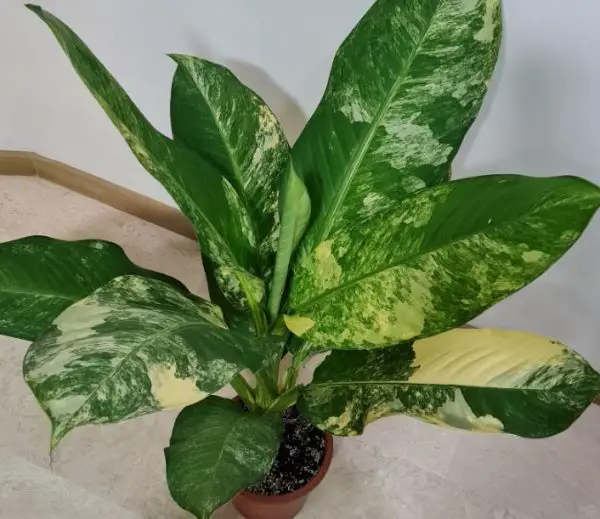
Because Dieffenbachia daguensis is an uncommon cultivar, grab the chance when you come across one. Its tall, sharp leaves are usually a rich green color with spots of yellowish color that give it a distinctive look.
This plant is sensitive to overwatering, so use caution when adding potting mix. Use well-draining soil amendments, such as pumice or perlite, to guard against root rot and promote strong development.
Dieffenbachia Triumph
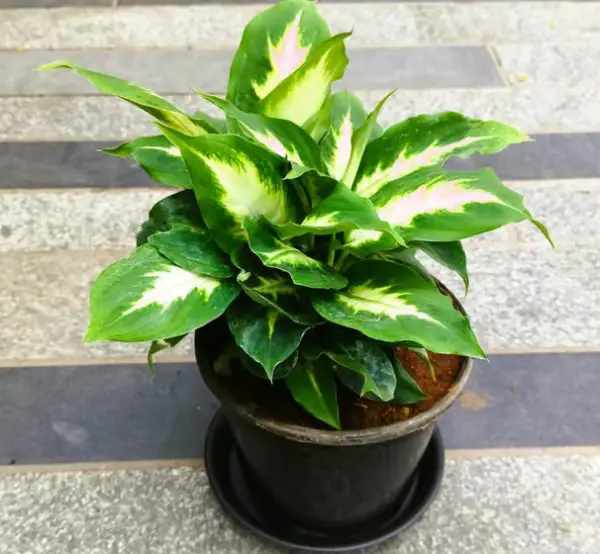
The Dieffenbachia Triumph hybrid is renowned for its exquisite foliage, which features lime green and deep green portions with white veining. Place your Triumph plant in bright, indirect sunlight, and keep the temperature between 70 and 80 degrees Fahrenheit to ensure it thrives.
It will remain colorful and develop healthily in this ideal setting, adding striking beauty to any collection of indoor plants.
Dieffenbachia Aurora
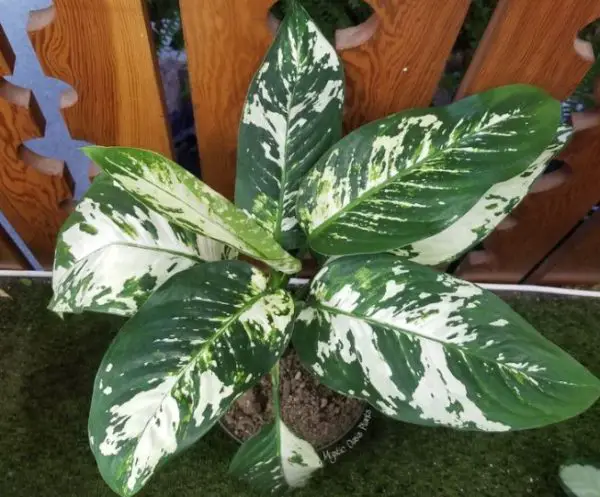
Dieffenbachia Aurora leaves with white blotches and dots are a favorite among plant collectors. This cultivar is perfect for any household because it usually grows no taller than three feet. Similar to its cousins, Aurora cannot survive in low light or direct sunshine, nor can it withstand an excessive amount of moisture in the soil.
Free-draining soil and strong indirect sunlight are ideal for Dieffenbachia aurora growth since they promote robust and healthy development.
Dieffenbachia Camouflage

Dieffenbachia Camouflage is a spectacular variety known for its green oval-shaped leaves adorned with veinings and dark blotches. This plant comes in different shades of green, depending on the cultivar.
If you have a cultivar with bright shades of green, ensure it receives plenty of bright light, but keep it away from full sun to prevent leaf damage. The unique pattern of its foliage makes the Camouflage a fascinating addition to any indoor garden.
Dieffenbachia Star Bright
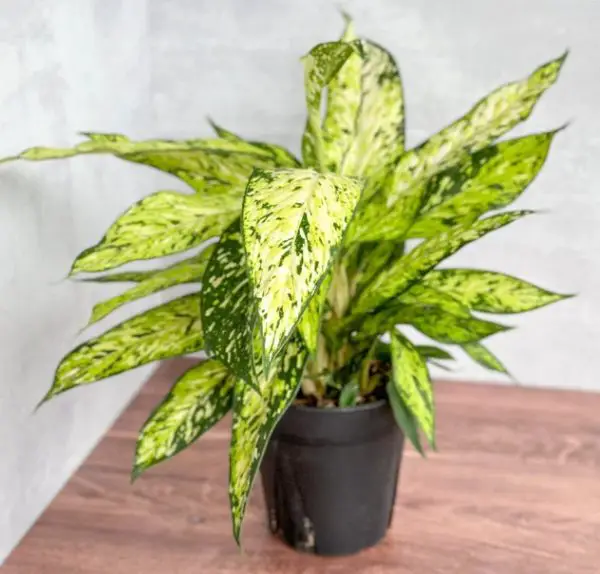
Among the genus, Dieffenbachia Star Bright is distinguished by its unusually slender leaf. With speckles that range from dark green to white, yellow, and lime green, every leaf has a different design. Avert overwatering and make sure the growth substrate is properly drained to prevent root rot.
Furthermore, Star Bright is best suited for outdoor growing only in USDA hardiness zones 10–12 because it cannot withstand even brief periods of frost. Dieffenbachia Star Bright lends a bit of originality to any indoor or outdoor area with its striking appearance and particular maintenance needs.
Dieffenbachia Sparkles
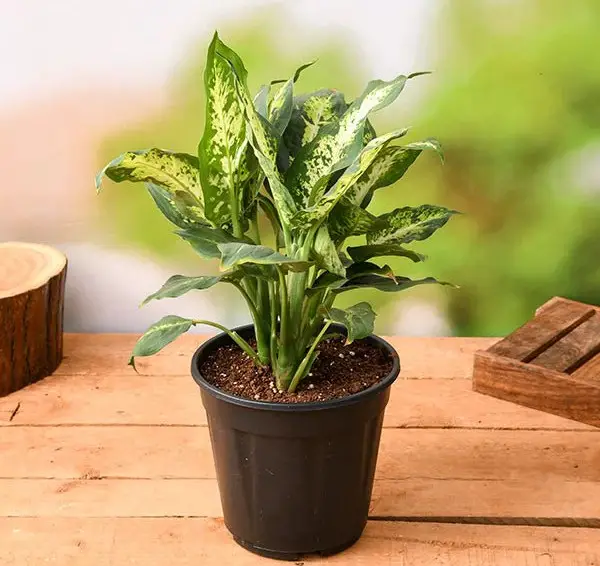
Dieffenbachia Sparkles, a product of tissue-culture laboratories for commercial foliage production, features charming, lightly variegated leaves with green margins and white midribs. Ideal for novice gardeners, Sparkles tolerates various growing conditions.
Ensure it receives indirect light and moderate to high humidity, planting it in a free-draining medium. Water when the top 2 inches of soil dry out, providing a balanced environment for healthy growth. With its resilience and attractive foliage, Dieffenbachia Sparkles adds beauty to any indoor space effortlessly.
Dieffenbachia maculata Exotica
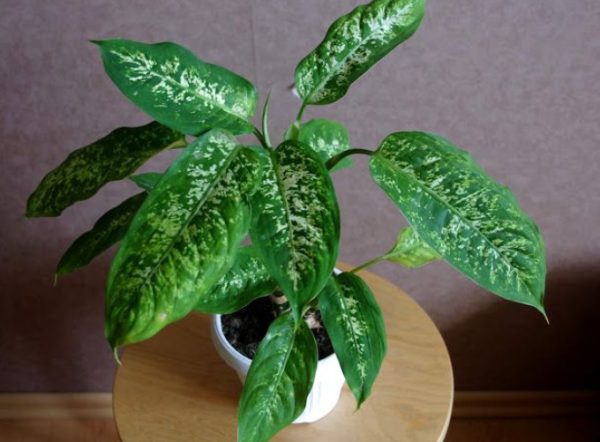
Dieffenbachia maculata Exotica, a delightful close relative of Tropical Tiki, with leaves with creamy centers and deep green borders that are more verdant than the Camille type. It grows erect and usually reaches a height of two feet inside.
Plant Exotica in a free-draining, rich medium, making sure it gets enough nutrients to support its growth. Dieffenbachia maculata Exotica lends a touch of elegance to any indoor environment with its eye-catching leaves and modest size.
Dieffenbachia Delilah
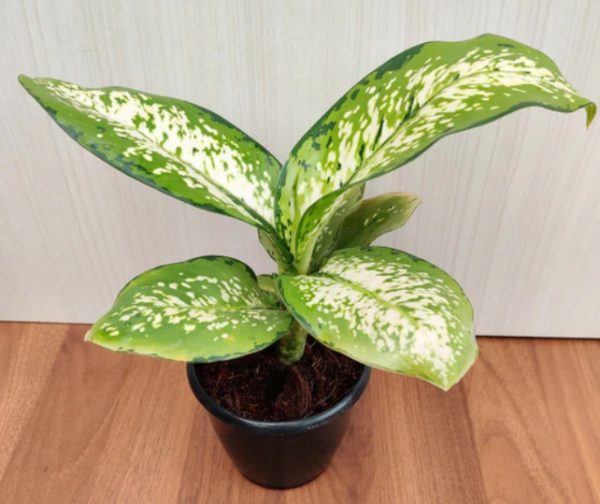
Dieffenbachia Delilah is a very different cultivar that draws attention with its tall leaves that have completely white centers and green borders. Even though I think white leaves are so beautiful, their lack of chlorophyll means that they actually need more light. Don’t choose low light, but don’t choose direct sunlight either.
Plant parents that are eager can benefit from Delilah’s quick growth rate and its thick, waxy leaves, which make it very pest-resistant. Among Dieffenbachias, Delilah is undoubtedly a treasure.
Dieffenbachia Tropic Marianne
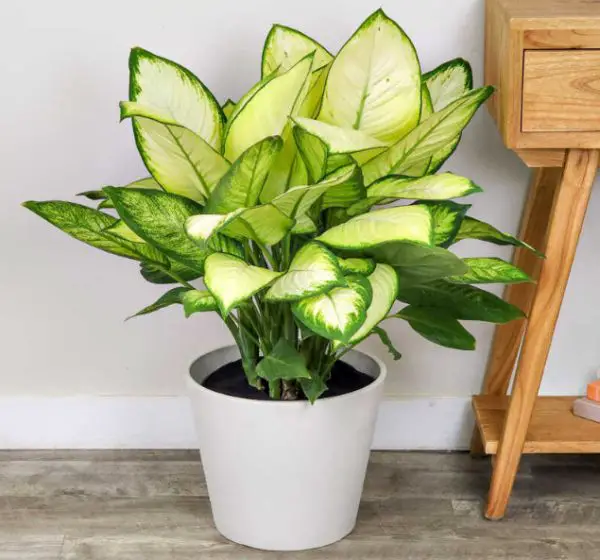
Large golden leaves with green edges is a feature of Dieffenbachia Tropic Marianne. Typically standing around thirty inches, it is ideal for compact apartments. Although Dieffenbachias may survive in low light, I advise Tropic Marianne to be placed in an area with lots of bright indirect sunlight.
Tropic Marianne, like its siblings, is an air-purifying plant that efficiently eliminates airborne pollutants such as toluene. Tropic Marianne brightens up any interior space and has health advantages because to its brilliant foliage.
Dieffenbachia Compacta
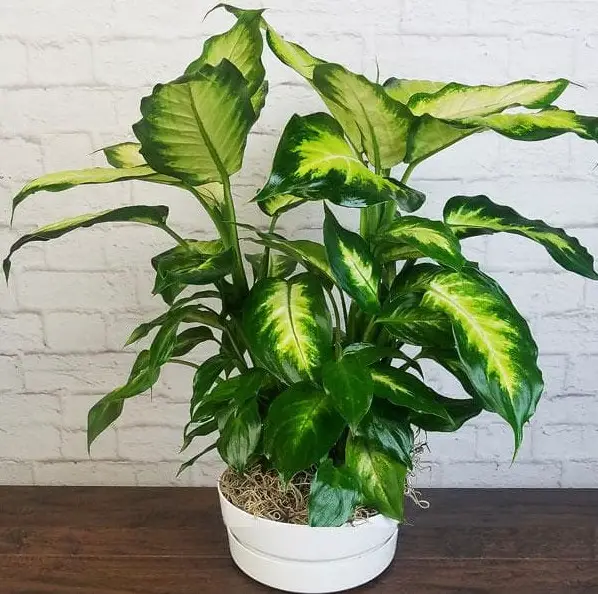
Dieffenbachia Compacta stays true to its name, growing no more than 19 inches in height. Its large, creamy leaf, mottled with green, gives it a striking appearance despite its diminutive size.
Compacta is great for tiny settings and works well for tabletops or shelves. To keep this attractive plant flourishing and vivid, make sure it receives enough light exposure. If natural sunlight is scarce, think about supplementing with artificial lighting. Dieffenbachia Compacta brings a little greenery indoors with its unique foliage and small dimensions.






